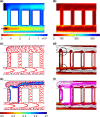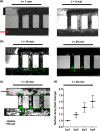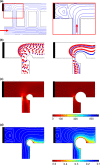Dynamics of blood flow and thrombus formation in a multi-bypass microfluidic ladder network
- PMID: 28580033
- PMCID: PMC5450919
- DOI: 10.1007/s12195-016-0470-7
Dynamics of blood flow and thrombus formation in a multi-bypass microfluidic ladder network
Abstract
The reaction dynamics of a complex mixture of cells and proteins, such as blood, in branched circulatory networks within the human microvasculature or extravascular therapeutic devices such as extracorporeal oxygenation machine (ECMO) remains ill-defined. In this report we utilize a multi-bypass microfluidics ladder network design with dimensions mimicking venules to study patterns of blood platelet aggregation and fibrin formation under complex shear. Complex blood fluid dynamics within multi-bypass networks under flow were modeled using COMSOL. Red blood cells and platelets were assumed to be non-interacting spherical particles transported by the bulk fluid flow, and convection of the activated coagulation factor II, thrombin, was assumed to be governed by mass transfer. This model served as the basis for predicting formation of local shear rate gradients, stagnation points and recirculation zones as dictated by the bypass geometry. Based on the insights from these models, we were able to predict the patterns of blood clot formation at specific locations in the device. Our experimental data was then used to adjust the model to account for the dynamical presence of thrombus formation in the biorheology of blood flow. The model predictions were then compared to results from experiments using recalcified whole human blood. Microfluidic devices were coated with the extracellular matrix protein, fibrillar collagen, and the initiator of the extrinsic pathway of coagulation, tissue factor. Blood was perfused through the devices at a flow rate of 2 µL/min, translating to physiologically relevant initial shear rates of 300 and 700 s-1 for main channels and bypasses, respectively. Using fluorescent and light microscopy, we observed distinct flow and thrombus formation patterns near channel intersections at bypass points, within recirculation zones and at stagnation points. Findings from this proof-of-principle ladder network model suggest a specific correlation between microvascular geometry and thrombus formation dynamics under shear. This model holds potential for use as an integrative approach to identify regions susceptible to intravascular thrombus formation within the microvasculature as well as extravascular devices such as ECMO.
Keywords: mass transfer; microfluidic network; multi-bypass ladder; platelets; shear; thrombin.
Conflict of interest statement
CONFLICTS OF INTEREST J. Zilberman-Rudenko, J.L. Sylman, H.H.S. Lakshman, O.J.T. McCarty and J. Maddala declare no competing financial interests.
Figures







Similar articles
-
Mathematical analysis of mural thrombogenesis. Concentration profiles of platelet-activating agents and effects of viscous shear flow.Biophys J. 1989 Dec;56(6):1121-41. doi: 10.1016/S0006-3495(89)82760-2. Biophys J. 1989. PMID: 2611327 Free PMC article.
-
Novel Stenotic Microchannels to Study Thrombus Formation in Shear Gradients: Influence of Shear Forces and Human Platelet-Related Factors.Int J Mol Sci. 2019 Jun 18;20(12):2967. doi: 10.3390/ijms20122967. Int J Mol Sci. 2019. PMID: 31216638 Free PMC article.
-
Coagulation Factor XI Promotes Distal Platelet Activation and Single Platelet Consumption in the Bloodstream Under Shear Flow.Arterioscler Thromb Vasc Biol. 2016 Mar;36(3):510-7. doi: 10.1161/ATVBAHA.115.307034. Epub 2016 Jan 14. Arterioscler Thromb Vasc Biol. 2016. PMID: 26769048 Free PMC article.
-
Use of microfluidics to assess the platelet-based control of coagulation.Platelets. 2017 Jul;28(5):441-448. doi: 10.1080/09537104.2017.1293809. Epub 2017 Mar 30. Platelets. 2017. PMID: 28358995 Review.
-
Microfluidics and coagulation biology.Annu Rev Biomed Eng. 2013;15:283-303. doi: 10.1146/annurev-bioeng-071812-152406. Epub 2013 May 3. Annu Rev Biomed Eng. 2013. PMID: 23642241 Free PMC article. Review.
Cited by
-
Blood Flow Velocimetry in a Microchannel During Coagulation Using Particle Image Velocimetry and Wavelet-Based Optical Flow Velocimetry.J Biomech Eng. 2021 Sep 1;143(9):091004. doi: 10.1115/1.4050647. J Biomech Eng. 2021. PMID: 33764427 Free PMC article.
-
Endothelial cell culture in microfluidic devices for investigating microvascular processes.Biomicrofluidics. 2018 May 15;12(4):042203. doi: 10.1063/1.5024901. eCollection 2018 Jul. Biomicrofluidics. 2018. PMID: 29861814 Free PMC article.
-
Platelet Mechanobiology Inspired Microdevices: From Hematological Function Tests to Disease and Drug Screening.Front Pharmacol. 2022 Jan 20;12:779753. doi: 10.3389/fphar.2021.779753. eCollection 2021. Front Pharmacol. 2022. PMID: 35126120 Free PMC article. Review.
-
Versatile Vessel-on-a-Chip Platform for Studying Key Features of Blood Vascular Tumors.Bioengineering (Basel). 2021 Jun 9;8(6):81. doi: 10.3390/bioengineering8060081. Bioengineering (Basel). 2021. PMID: 34207754 Free PMC article.
-
Catastrophic Intracardiac Thrombosis During Emergency Repair of an Expanding Aortic Pseudoaneurysm: A Case Report.A A Pract. 2019 Nov 1;13(9):342-345. doi: 10.1213/XAA.0000000000001079. A A Pract. 2019. PMID: 31567269 Free PMC article.
References
-
- Bird RB, Stewart WE, Lightfoot EN. Transport Phenomena. New York: Wiley; 1960.
Grants and funding
LinkOut - more resources
Full Text Sources
Other Literature Sources

